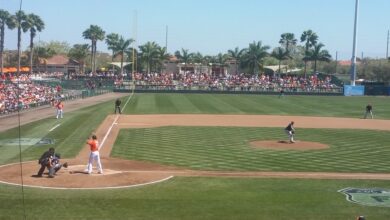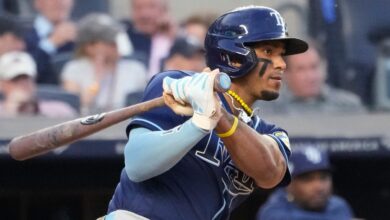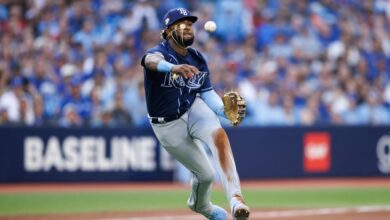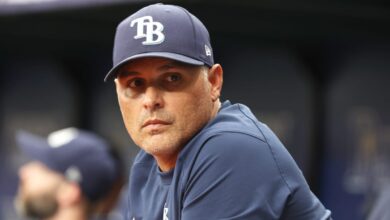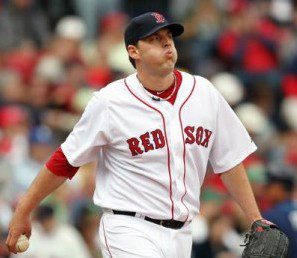
During the first few weeks of the season, a certain amount of roster shuffling is natural. Maybe you took a flier on Jonny Venters because you thought he was going to time-share with Craig Kimbrel, or maybe you snatched Jesus Montero with the logical thought that his bat was too good for AAA (I was guilty on Venters, for what it’s worth). If you threw a couple dollars at these guys in an auction, or drafted them in the last couple rounds, that’s fine. That’s what the end of the draft is for, after all. However, wild reactions to a bad first week are sweeping the fantasy nation. Here are just a few of the drops in my own leagues (standard 5×5 rotisserie with a snake draft):
Ryan Franklin (Round 20) for Brian Fuentes
Mark Reynolds (Round 19) for Coco Crisp
Josh Beckett (Round 18) for Brandon Morrow
Max Scherzer (Round 10) for Chris Narveson
Matt Holliday (Round Two) for Jim Thome
That’s right, a second-round pick was dropped in the first week of the season for a part-time DH. Try to figure that one out.
We’ve all made terrible roster moves, though, on the off-chance that an early-season waiver claim will lead us to the fantasy crown. However, for every 2010 Casey McGehee (solid, steady production all year), there’s a 2009 Emilio Bonifacio (great first month, horrible rest of the season).
What can’t be stressed enough here is that a 10-game sample size is, in a lot of cases, completely meaningless. Just because Nelson Cruz has five home runs doesn’t mean he’s going to end up with 80 at the end of season. Baseball doesn’t work that way. However, we can delve a bit deeper and discover a few things that can help fantasy rosters. Let’s take a look at some hot and cold players, and whether you should buy, sell, or hold (we’ll cover the American League today, and cover the National League later in the week). Assume that we’re looking at non-keepers here.
Austin Jackson: If you’ve drafted Jackson, you were (hopefully) looking for runs and steals. He already has five runs and two steals, so it’s a bit confusing that he’s being dropped in so many leagues. With an abnormally high BABIP (batting average on balls in play) of .396 in 2010, he was due for a regression in his batting average. Naturally, in his first nine games of 2011, his BABIP is .261. League average is about .300, so his batting average should rise a bit from where it is, likely into the .240-to-.250 range. His runs and steals are still going to be there, so if you need speed and can spare a lower average and power, go ahead and buy.
Edwin Encarnacion: The classic one-category player. He’s usually good for 20-25 home runs per year, but is stuck on zero for now. On top of that, the batting average is low and he’s hurt. With Brett Lawrie coming off a very nice spring and clearly being the third baseman of the Jays’ future, sell Encarnacion off if you can or flat-out release him. There’s plenty of third basemen in the sea. Like our next contestant, for example.
Alex Gordon: Gordon has also been known as Fantasy Kryptonite. A projected five-tool player, Gordon has never put it all together. But year after year, someone spends a high fantasy pick on him.
Of course, the year everyone finally moves on is the year that he gets off to a hot start. A .357 batting average with one home run, five RBIs, and nine runs in his first nine games has him being snapped up in most leagues where he’s available. His current BABIP (.438) is definitely not sustainable and is also 140 points above his career average, and the Royals will absolutely be coming back to Earth any second now. That being said, if you’ve got him, you might as well hold on to him for the home run potential.
Russell Martin/Jorge Posada: Here’s our first of two combo platters, in the Yankee catching platoon. Martin’s an interesting case in that he’s only had one full season of 15+ home runs (19, in 2007), but already has three in the season’s first 10 days. Injuries and ineffectiveness since then have made him useless in fantasy, but it’s possible that moving to the loaded Yankees lineup and a change in scenery can bring him back. Three years of declining stats, though, aren’t offset by a hot start, at least for me. If you’re catcher-desperate, grab him, I suppose, but hold if you can.
Posada, on the other hand, you should buy. Low average aside, he’s always had 20+ home run power, and, because he’s the full-time DH rather than the catcher, the usual wear and tear does not apply. He can definitely continue to prove worthy of a roster spot.
Ryan Raburn/Brennan Boesch: Our other platoon is in the Detroit outfield. Boesch (.308, one HR, five RBI, eight runs) is off to a better start than Raburn (.227, one HR, three RBI, two runs), but there should be better options out there than either. They’re going to platoon all year, so unless you want to save a roster spot for an outfielder who won’t play more than 90 to 100 games, sell on both.
Kyle Drabek: The centerpiece of the Roy Halladay trade is finally making an impact in the majors. Through his first two starts, Drabek’s allowed only two earned runs in 13 innings, with 12 strikeouts and a WHIP of 1.08. The three biggest problems here are that Drabek has never pitched more than 162 innings, he’ll routinely be facing the monster lineups of the AL East, and he’s walking a fair amount of batters. Should he be picked up while he’s still available? Grab him now, but wait and see how he does against the Red Sox and Yankees before deciding whether to trade him or hold.
Zach Britton: A lot of what applies to Drabek applies here as well. The differences are that Britton, in a very small sample size, has less strikeouts, and has pitched even fewer innings (153 between AA and AAA last year). He may also get squeezed when Brian Matusz comes back from the DL in a few weeks. If you’re in a keeper league, buy if at all possible, but if you’re trying to win this year, it’s a much riskier proposition.
Michael Pineda: Here’s a pitcher that was picked up in a ton of leagues before the season, and is now getting dropped just as rapidly after one start. And, that one start wasn’t even bad: three earned runs in six innings with four strikeouts. The interesting thing is that I think a 4.50 ERA and a K/9 of between six and seven is about what he’ll do all season, so it’s unclear why so many owners jumped on board then jumped off immediately. In any case, you could do worse than this (see below) for a back-end starter, so I hold.
John Lackey: If you were drafting Lackey for anything other than 14-15 wins, decent strikeouts, and a decent ERA, than you were in trouble in the first place. Nine years in the majors have proven that that’s what Lackey is. However, a lot of owners were understandably dumping him after two horrific starts (an ERA over 15 and getting hit harder than that, even).
Here’s the thing, though. He was facing two loaded lineups in the Rangers at Texas, and the Yankees in Fenway. He also has a lot going for him in the Boston lineup to get soft wins, and years of watching him show that, while he’s not a fantasy ace, he’s definitely better than he’s shown thus far in 2011. Plus, if you can get him off the waiver wire, his currently putrid numbers can’t hurt you. Buy low if you need an occasional starter.
Phil Hughes: Another back-end starter that’s been getting crushed early in 2011 (16.50 ERA in two starts). Unlike Lackey, though, it’s being reported that his pitches have lost significant velocity from 2010. This early in the season, that’s a troubling sign. Because the Yankees are going to be in a dogfight for the AL East all season, and also because they have some majors-ready depth behind Hughes (Bartolo Colon, Kevin Millwood, Carlos Silva), it might be worth selling off Hughes and letting him be someone else’s problem for the year.
As mentioned earlier, the samples available so far aren’t generally conclusive, so making a lot of roster moves at this point in the season is definitely risky. Take a deep breath and relax. It’s a long season.
We’ll cover the National League separately. Agree? Disagree? Would you also have dropped Matt Holliday a week into the season? Comment below, and let’s discuss.


